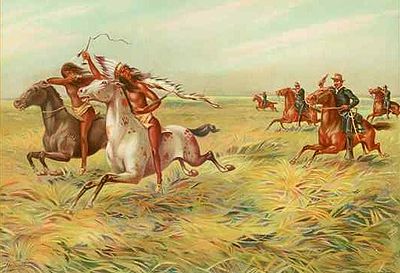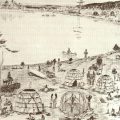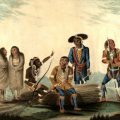During the 17th century, four European countries—France, England, Netherlands, and Spain–established permanent colonies in the Americas. As these colonies expanded, the conflicts with the Native Americans over land increased in frequency and intensity. While the American Indian nations had superior numbers, the Europeans had a technological advantage.

The Europeans were driven to conquer the “wilderness” of the Americas by the power of greed. They sought wealth in the form of gold and silver, fertile lands which could be used to grow crops which could then be exported to Europe, furs and hides for the European market, and finally slaves.
As contact with the Europeans intensified, so did the diseases which they brought with them. Along the Atlantic coast, disease killed up to 90% of the Indian inhabitants during this century.
Listed below are some of the events of 1614.
English:
In 1613, the English had kidnapped Pocahontas, the favorite daughter of Powhattan, a powerful Indian leader. They had hoped to hold her for ransom, but the Indians refused to pay a ransom. In 1614, as a condition of her release from her English captors, Pocahontas agreed to marry John Rolfe and became known as Rebecca Rolfe. At the marriage ceremony, Pocahontas was given away by her uncle Opechancanough.
At the time of her marriage, Pocahontas was about 18 and had been married to a warrior named Kocoum. She was fairly slender and could pass for a boy, a feature which would later allow her to have an audience with King James.
The English colonists in Virginia concluded a formal, written treaty with the Chickahominy in which the Indians agreed to send an annual tribute payment of corn to Jamestown. The treaty between the English and the Chickahominy appears to have been masterminded by Opechancanough. Opechancanough wanted the English to think that the Chickahominy were their allies while drawing the Chickahominy closer to membership in the Powhattan empire.
In Massachusetts, the English returned with Capawake sachem Epinow, who was to act as their guide and interpreter. Epinow, however, escaped from the ship by jumping into the water and swimming toward some Indian canoes. The Indians in the canoes fired a volley of arrows at the ship to aid his escape.
In Massachusetts, English Captain Thomas Hunt captured 26 Wampanoag, including a young man known as Squanto. The Indians were taken to Spain and sold as slaves. However, Squanto escaped and found his way to England where he learned to speak English.
John Smith, the former commander at Jamestown, led two ships in search of gold and whales along the coast of Maine. After some fishing, trading, and skirmishes with the natives, the English captured 27 Wampanoag and Nauset to sell into slavery. While mapping the New England coast, Smith noted at least nine coastal towns between Cape Ann and Cape Code, each of which was ruled by a sachem. In addition, he reported that he had heard that there were more than 20 towns inland from the coast.
French:
The Compagnie de Canada won a monopoly on trade in the St. Lawrence for eleven years. The new company was to transport six families to begin a settlement in New France.
A formal trading alliance was formed between the French and the Huron Confederacy. As a result of this agreement, Huron society would undergo great changes.
Dutch:
The Dutch granted exclusive trading rights to the Hudson River area of New York to the New Netherlands Company which built a trading fort on Castle Island. The trader Jacob Elkens learned both the Mahican and Mohawk languages.
Disease:
A series of three epidemics began to sweep through the Indian villages in Massachusetts. At least ten Wampanoag villages were abandoned because there were no survivors. Wampanoag population decreased from 12,000 to 5,000.
Mohawk:
In New York, the Mohawk who were living at the Kilts site (NYSM 6297—this is the archaeological designation for the site) moved their town to the Wagner’s Hollow (NYSM 1202 and NYSM 1214) area on Caroga Creek.




Leave a Reply